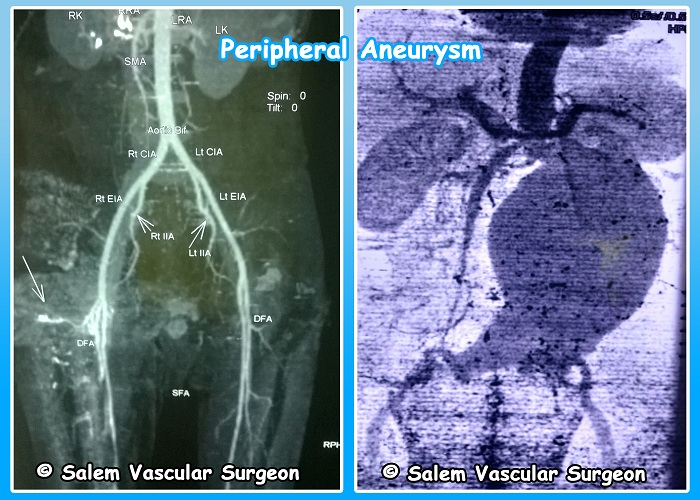Peripheral Aneurysm

Peripheral Aneurysm
A weakening in the wall of a blood vessel in your abdomen or sometimes in a leg which results in an abnormally dilated area. This dilated area is prone to:
- Clotting off and interrupting blood flow.
- Rupturing and causing serious bleeding.
- Compressing adjacent tissues.
Usually Genetic, Rarely Occur
- Peripheral aneurysms are usually genetic; that is, you are born with the tendency to form them.
- Aneurysms in the abdomen, called splenic aneurysms, are uncommon, affecting 0.7% of the population.
- Peripheral aneurysms in the legs are very rare, affecting 0.007% of men, and even fewer women.
May Require Treatment
If you develop a peripheral aneurysm, it will not go away unless treated.
- Most peripheral aneurysms over 2 cm in diameter require treatment.
- In some cases even smaller aneurysms may require treatment.
Symptoms
- Many peripheral aneurysms cause no symptoms and are found when your doctor does a physical or performs testing for other reasons.
- May indicate that a splenic aneurysm in your abdomen is causing bleeding.
- May signal interrupted blood flow an aneurysm in your leg. In rare cases, may indicate compression of nearby nerves or compression of a vein next to the aneurysm.
- “Blue toes” may indicate the presence of small blood clots washed down from elsewhere. This condition heals on its own in 2-3 months.
Causes
- If family members have had an aneurysm you are more likely to have one.
- Having one peripheral aneurysm increases the risk of developing another one elsewhere.
- Smoking is the major controllable cause of aneurysm growth.
- For women, splenic aneurysms in the abdomen have a tendency to grow during pregnancy and are more common for mothers who have had many children.
Diagnosis
Peripheral aneurysms are often identified in a physical exam. If so, make an appointment to see a vascular surgeon.
If a peripheral aneurysm is suspected, duplex ultrasound and computerized tomography (CT) scans are good tests to confirm its presence.
If your vascular surgeon prescribes treatment, a computerized tomography (CT) angiography or catheter angiography may be needed.
